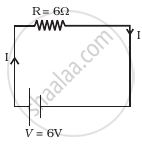Advertisements
Advertisements
प्रश्न
Consider the following statements.
(A) Free-electron density is different in different metals.
(B) Free-electron density in a metal depends on temperature.
Peltier Effect is caused _______________ .
पर्याय
due to both A and B
due to A but not due to B
due to B but not due to A
neither due to A nor due to B
उत्तर
due to A but not due to B
In Peltier Effect, one of the junctions gets heated up and the other cools down when electric current is maintained in a circuit of material consisting of two dissimilar conductors.
This is caused due to the difference in density of free electrons in different metals. When two different metals are joined to form a junction, the electrons tend to diffuse from the side with higher concentration to the side with lower concentration. If current is forced through the junction, positive or negative work is done on the charge carriers, depending on the direction of the current. Accordingly, thermal energy is either produced or absorbed. Thus, Peltier Effect is caused due to A but not due to B.
APPEARS IN
संबंधित प्रश्न
Derive an expression for drift velocity of free electrons.
What is its relation with relaxation time?
Write its (‘mobility’ of charge carriers) S.I. unit
The number density of free electrons in a copper conductor is 8.5 × 1028 m−3. How long does an electron take to drift from one end of a wire 3.0 m long to its other end? The area of cross-section of the wire is 2.0 × 10−6 m2 and it is carrying a current of 3.0 A.
How does drift velocity of electrons in a metallic conductor vary with increase in temperature? Explain.
On the basis of electron drift, derive an expression for resistivity of a conductor in terms of number density of free electrons and relaxation time. On what factors does resistivity of a conductor depend?
Define relaxation time of the free electrons drifting in a conductor. How is it related to the drift velocity of free electrons? Use this relation to deduce the expression for the electrical resistivity of the material.
A conductor of length ‘l’ is connected to a dc source of potential ‘V’. If the length of the conductor is tripled by gradually stretching it, keeping ‘V’ constant, how will (i) drift speed of electrons and (ii) resistance of the conductor be affected? Justify your answer.
A current of 1.0 A exists in a copper wire of cross-section 1.0 mm2. Assuming one free electron per atom, calculate the drift speed of the free electrons in the wire. The density of copper is 9000 kg m–3.
Consider a wire of length 4 m and cross-sectional area 1 mm2 carrying a current of 2 A. If each cubic metre of the material contains 1029 free electrons, find the average time taken by an electron to cross the length of the wire.
Consider the following statements.
(A) Free-electron density is different in different metals.
(B) Free-electron density in a metal depends on temperature.
Seebeck Effect is caused _____________ .
Obtain the expression for the current flowing through a conductor having number density of the electron n, area of cross-section A in terms of the drift velocity vd .
Metals are good conductor of heat than insulator because
An electric bulb.is rated 220 v and 100 watt power consumed by it when operated on 'no volt is:-
The drift velocity of a free electron inside a conductor is ______
Is the momentum conserved when charge crosses a junction in an electric circuit? Why or why not?
- Consider circuit in figure. How much energy is absorbed by electrons from the initial state of no current (ignore thermal motion) to the state of drift velocity?
- Electrons give up energy at the rate of RI2 per second to the thermal energy. What time scale would one associate with energy in problem (a)? n = no of electron/volume = 1029/m3, length of circuit = 10 cm, cross-section = A = (1mm)2

Define relaxation time.
Derive an expression for resistivity of a conductor in terms of the number density of charge carriers in the conductor and relaxation time.
The potential difference applied across a given conductor is doubled. How will this affect (i) the mobility of electrons and (ii) the current density in the conductor? Justify your answers.
